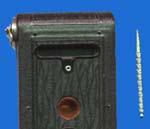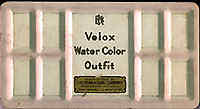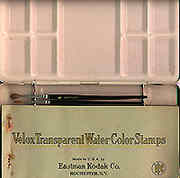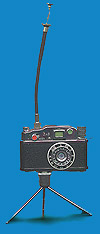The AUTOGRAPHIC feature,
from 1914

STYLUS & DOOR (on the back of the VP-KODAK
camera)
The autographic feature was introduced
by KODAK in 1914. And many cameras in that era came with it. The 'autographic'
added to the camera's name.
INSTRUCTIONS:
1. Load the camera with an autographic-film.
(a special film with a tissue between the film and the paper).
2. Open the door - located at the
back of the camera.
3. write with the special stylus
your date or description.
4. Close the door.
5. Take the picture.
In the 30's when the films became
too sensetive to light the feature 'died' to come back later at a completely
new form as the DATE in the modern camera.
The RED WINDOW
(
the red circular window as seen in the previous pic.)
The red window on the back of
the camera was a simple yet efficient way to know the location of the film
and what picture is it now.
The patent invented in the 1890's
and bought by EASTAMN for the Kodak line of cameras.
The film: white
numbers printed on a special black paper behind the celuloid-film. The
paper was longer than the film to protect it from the light when loaded/unloaded.
The window:
Located on the back of the camera. through it the white numbers could be
seen.
The red window died when the
films got more sensitive to the light and mechanical and later electronic
counters where used.
How to restore a red-window:
if it's missing or broken- use an exposed or used film and you get the
same effect.
WATER COLORS
for B/W PICTURES
Until the color processing became
the standart: studios offered the coloring of the B/W photos with delicate
transparent water colors thus addind life and beauty to the pictures (if
done well...).
KODAK offered a DO IT YOURSELF
outfit:


Color your own prints and enlargement
with
VELOX TRANSPARENT WATER COLOR
STAMP OUTFIT
No experience necessary
The Outfit consists of an Artist's
Mixing Palette, three special Hair Brushes and a book of Velox Transparent
Water Color Stamps (12 colors).
Price .......................................
0.85$
September - 1911
MADE by EASTMAN KODAK Co.
(1910-1940?)
OTHER COLORING SET

NON CAMERAs:
CIGARETTE LIGHTER,
JAPAN , 1950s

I collect only cameras and photographica
BUT I couldn't resist that cute lighter: Just press the shutter-release-cord
and the flame burns up!



